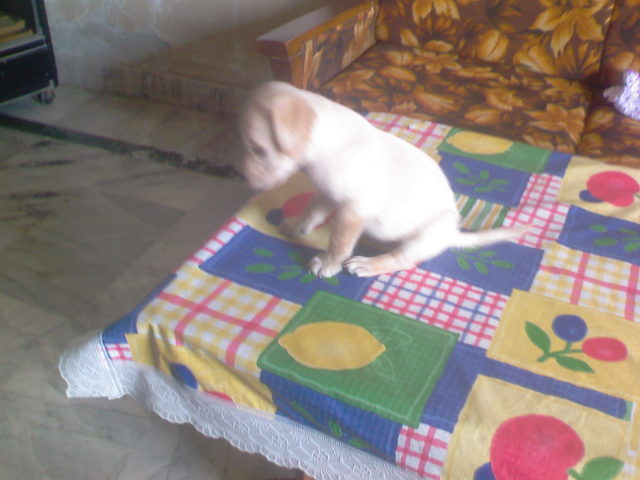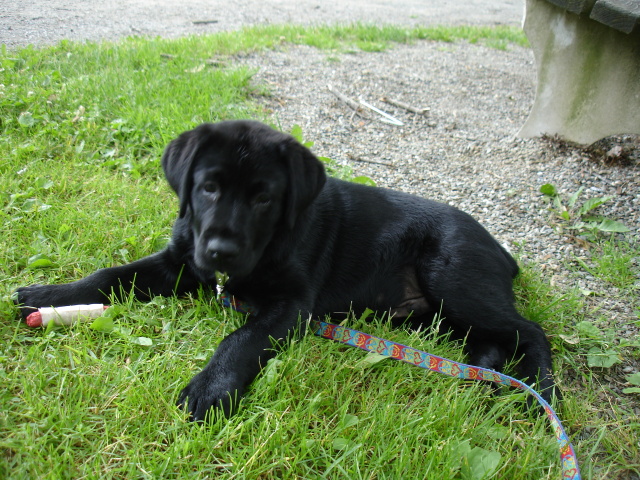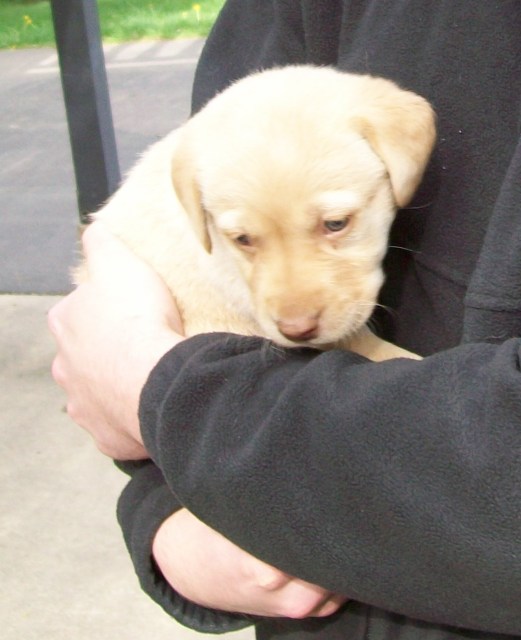QuestionQUESTION: we will be bringing in a year old black spayed lab. we have the option to have her sleep downstairs or upstairs with our daughter. so I was wondering with the possible hip issues later, should we not do the stairs thing, or does that really contribute to the hip dysphasia? thank you so much for your time! sharra
ANSWER: If your daughter wants to let her sleep with her, perhaps let her. How old is your daughter? Your daughter could be out of the house by the time the dog develops problems.
Watch for leadership problems. With somebody the right age in the family, 4-H dog training is a great idea. In my area, clubs form soon after the first of the year. Even many urban areas have 4-H. For info look in your phone book under government listings for extension or cooperative extension offices. Ask specifically about a dog or canine club. The dogs see all the people and dogs in the household as a pack with each having their own rank in the pack and a top dog. Life is much easier if the 2 legged pack members outrank the 4 legged ones. You can learn to play the role of top dog by reading some books or going to a good obedience class. A good obedience class or book is about you being top dog, not about rewarding standard commands a treat. Start at http://www.dogsbestfriend.com/ For more on being top dog, see http://www.dogbreedinfo.com./topdogrules.htm It likely is too late for 4-H this year, but consider it next year.
---------- FOLLOW-UP ----------
QUESTION: this leads to my next question: (regarding female lab), with the dog already being one year old, is it ok to crate her at bedtime since I do not know what she will do when I am asleep? and should I just always crate her, or should I eventually let her just lay on the floor (basically be free in the house). not sure what is best for her, and also for me to maintain my "leadership" role. thanks again!!
AnswerI am a great believer in the crate. It is also one more way of showing your leadership. I would say if you have any doubt about housebreaking or chewing, go ahead and crate her when nobody can watch her.
It is only natural that a puppy resists its crate at first. What the puppy wants more than anything else is to be others, you, anyone else in the household, and any other pets. In our modern society, even if we are home, other things distract us from the attention an uncrated puppy must have. The only real solution is to crate the dog when you aren't around. The dog may be happier in its den than loose in the house. It relaxes, it feels safe in its den. It rests, the body slows down reducing the need for water and relieving its self. Dogs that have been crated all along do very well. Many of them will rest in their crates even when the door is open. I think the plastic ones give the dog more of a safe, enclosed den feeling. Metal ones can be put in a corner or covered with something the dog can't pull in and chew. Select a crate just big enough for the full grown dog to stretch out in.
Leave it some toys. Perhaps a Kong filled with peanut butter. Don't leave anything in the crate the dog might chew up. It will do fine without even any bedding. You will come home to a safe dog and a house you can enjoy.
A dog that has not been crated since it was little, may take some work. Start out just putting its toys and treats in the crate. Praise it for going in. Feed it in the crate. This is also an easy way to maintain order at feeding time for more than one dog.
The "shut the puppy in a safe room" is a fallacy. Very few houses even have a safe room. How many of us have a room with a hard surfaced floor and nothing else? Most rooms have electrical cords to chew if nothing else. In addition to destroying anything a bored puppy finds to chew, it may choke or have intestinal blockage from the pieces. I had a friend that left her dog in a "safe" room. It ate a hole in the floor covering. The safe rooms fail to give the dog the comfort of the enclosed space their instinct requires. Nor do they restrict activity extending the time the dog can go without relieving itself.

 about my female dogs height
Question
sitting on table
i got a fawn coloured female
about my female dogs height
Question
sitting on table
i got a fawn coloured female
 Is my lab puppy growing to fast?
Questionjust hanging out!
QUESTION: I recently t
Is my lab puppy growing to fast?
Questionjust hanging out!
QUESTION: I recently t
 Lab Puppy Eye Color
Question
Yellow Puppy
We are looking at buying a 5 1/2
Lab Puppy Eye Color
Question
Yellow Puppy
We are looking at buying a 5 1/2
 Hyper active Labrador Pupp.
Question
Benji
Hello Jen,
&nbs
Hyper active Labrador Pupp.
Question
Benji
Hello Jen,
&nbs
 Need opinion about my Labrador Retriever
QuestionCoco (Labrador Retriev
QUESTION: I have
Need opinion about my Labrador Retriever
QuestionCoco (Labrador Retriev
QUESTION: I have